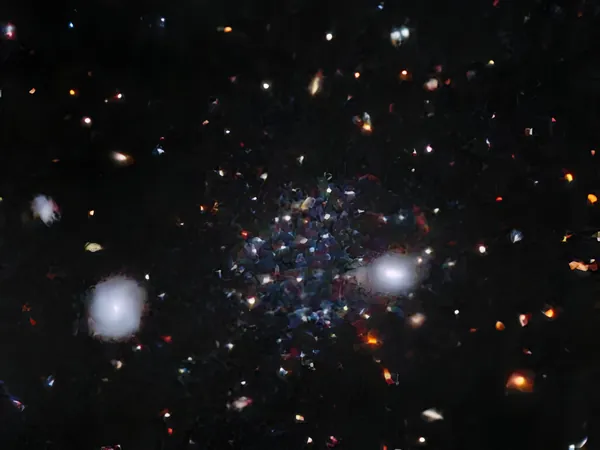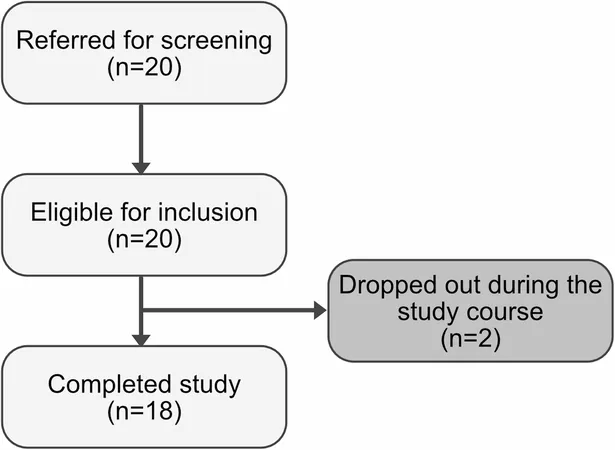
Mysterious 'Ghost Town' Galaxies Unveil Secrets of the Early Universe
2025-01-19
Author: Jia
In a groundbreaking discovery, astronomers have unveiled a trio of faint dwarf galaxies, known as Sculptor A, B, and C, located approximately 6.5 million light-years away from Earth. Nestled within a galaxy cluster surrounding NGC 300, these ultra-faint dwarf galaxies are a vital link to understanding the universe's infancy.
Characterized by their meager stellar populations, these dwarf galaxies hold just a few hundred to a few thousand stars compared to our Milky Way, which boasts an astounding hundreds of billions. The low luminosity of these galaxies often renders them invisible amidst the brighter, more dominant systems, making their discovery notably challenging.
What Makes These Galaxies Unique?
Led by Professor David Sand from the University of Arizona Steward Observatory, the research team asserts that these ancient galaxies act as time capsules from the early universe, offering invaluable insights into the periods when the first stars and galaxies began to emerge. Their study could illuminate why some regions of the cosmos ceased star formation and evolved into "silent" galaxies, devoid of newborn stars.
A Challenging Search
Uncovering the Sculptor galaxies was not a straightforward task. Professor Sand combined traditional observational techniques with modern technology to sort through images from the DECam Legacy Survey, ultimately discovering these galaxies by chance after extensive searching.
One remarkable aspect of the Sculptor galaxies is their isolation, which means they are not significantly influenced by larger galaxies like the Milky Way. This isolation strengthens hypotheses regarding their cessation of star formation.
Ghost Towns of the Cosmos
Observations using the Gemini South telescope revealed that the Sculptor galaxies are populated solely by very old stars and exhibit signs of halted star formation, making them resemble cosmic ghost towns that were once vibrant but are now quiet and desolate. Experts speculate that these galaxies may have lost their star-forming gas—a crucial substance needed for creating new stars—due to their insufficient gravitational strength, which makes it easy for nearby massive galaxies to strip them of this essential ingredient.
Professor Sand elaborated that various cosmic phenomena—including intense ultraviolet radiation from early stars, powerful supernova explosions, and gravitational influences from more massive neighbors—could have contributed to this loss of star-forming capability.
Unraveling Cosmic Mysteries
The isolation of the Sculptor galaxies suggests that their gas was unlikely stolen from neighboring giants, lending credence to the alternate theories regarding their stripped star-forming fuel. Furthermore, studying these dwarf galaxies may bridge our understanding between contemporary galaxies and their early formations, offering clues about the conditions that led to the diverse structures we see today.
In pursuit of more “ghost town” galaxies, researchers aim to employ advanced machine learning tools to enhance and expedite the discovery process. With upcoming next-generation telescopes, scientists anticipate a leap in our ability to survey the universe with unmatched depth and clarity, potentially revealing thousands of previously hidden ultra-faint dwarf galaxies.
The Broader Implications of Dwarf Galaxy Research
Examining these dwarf galaxies could significantly advance our understanding of dark matter—an enigmatic substance comprising much of the universe’s mass. Dwarf galaxies are believed to be high in dark matter, and investigating their profiles could shed light on how this mysterious matter is distributed and functions within the cosmos.
Ultimately, the ongoing exploration of these "ghost town" galaxies is poised to revolutionize our comprehension of galaxy formation and the fundamental forces governing the universe. As more discoveries unfold, we may gain unprecedented insights into both our cosmic past and the underlying dynamics that shape our universe today.
Stay tuned for further updates as researchers continue their quest to uncover the secrets lying within the depths of space!



 Brasil (PT)
Brasil (PT)
 Canada (EN)
Canada (EN)
 Chile (ES)
Chile (ES)
 Česko (CS)
Česko (CS)
 대한민국 (KO)
대한민국 (KO)
 España (ES)
España (ES)
 France (FR)
France (FR)
 Hong Kong (EN)
Hong Kong (EN)
 Italia (IT)
Italia (IT)
 日本 (JA)
日本 (JA)
 Magyarország (HU)
Magyarország (HU)
 Norge (NO)
Norge (NO)
 Polska (PL)
Polska (PL)
 Schweiz (DE)
Schweiz (DE)
 Singapore (EN)
Singapore (EN)
 Sverige (SV)
Sverige (SV)
 Suomi (FI)
Suomi (FI)
 Türkiye (TR)
Türkiye (TR)
 الإمارات العربية المتحدة (AR)
الإمارات العربية المتحدة (AR)